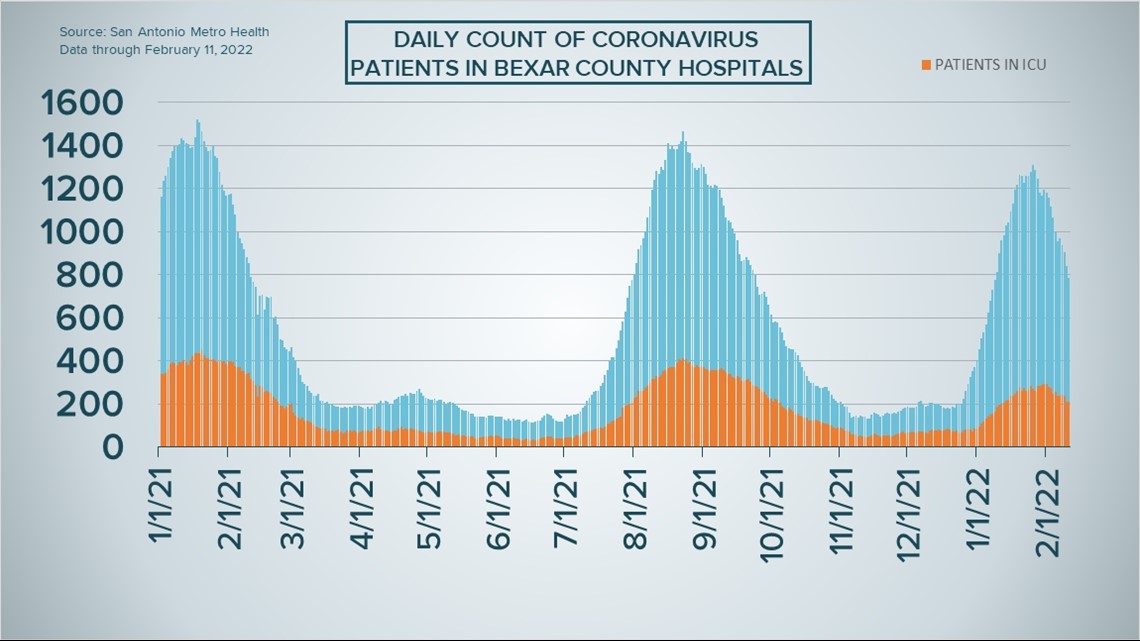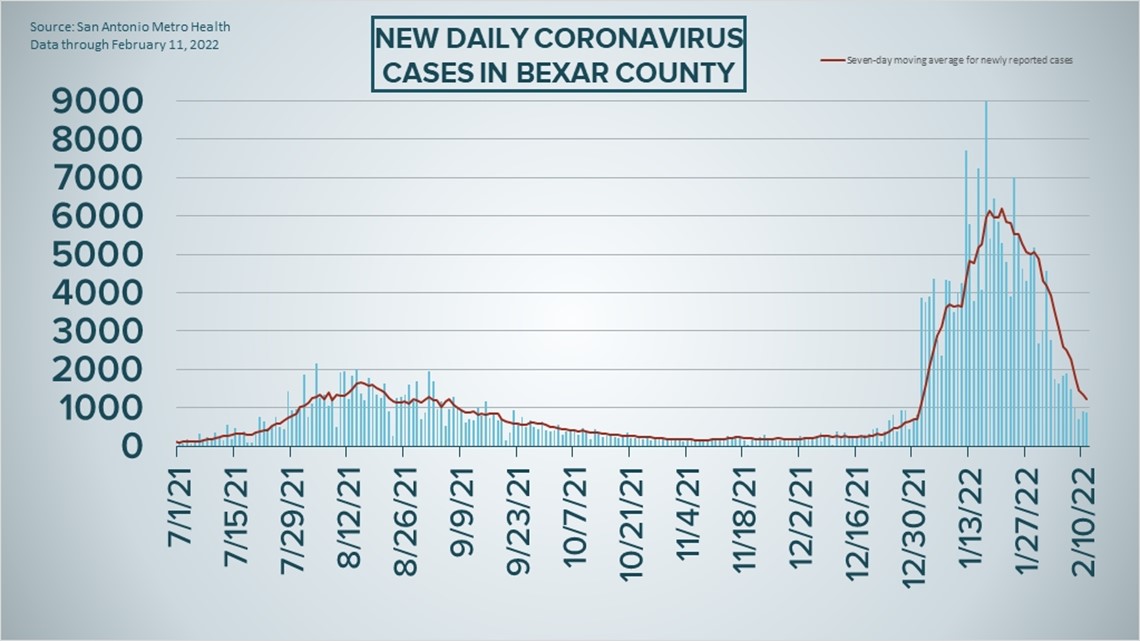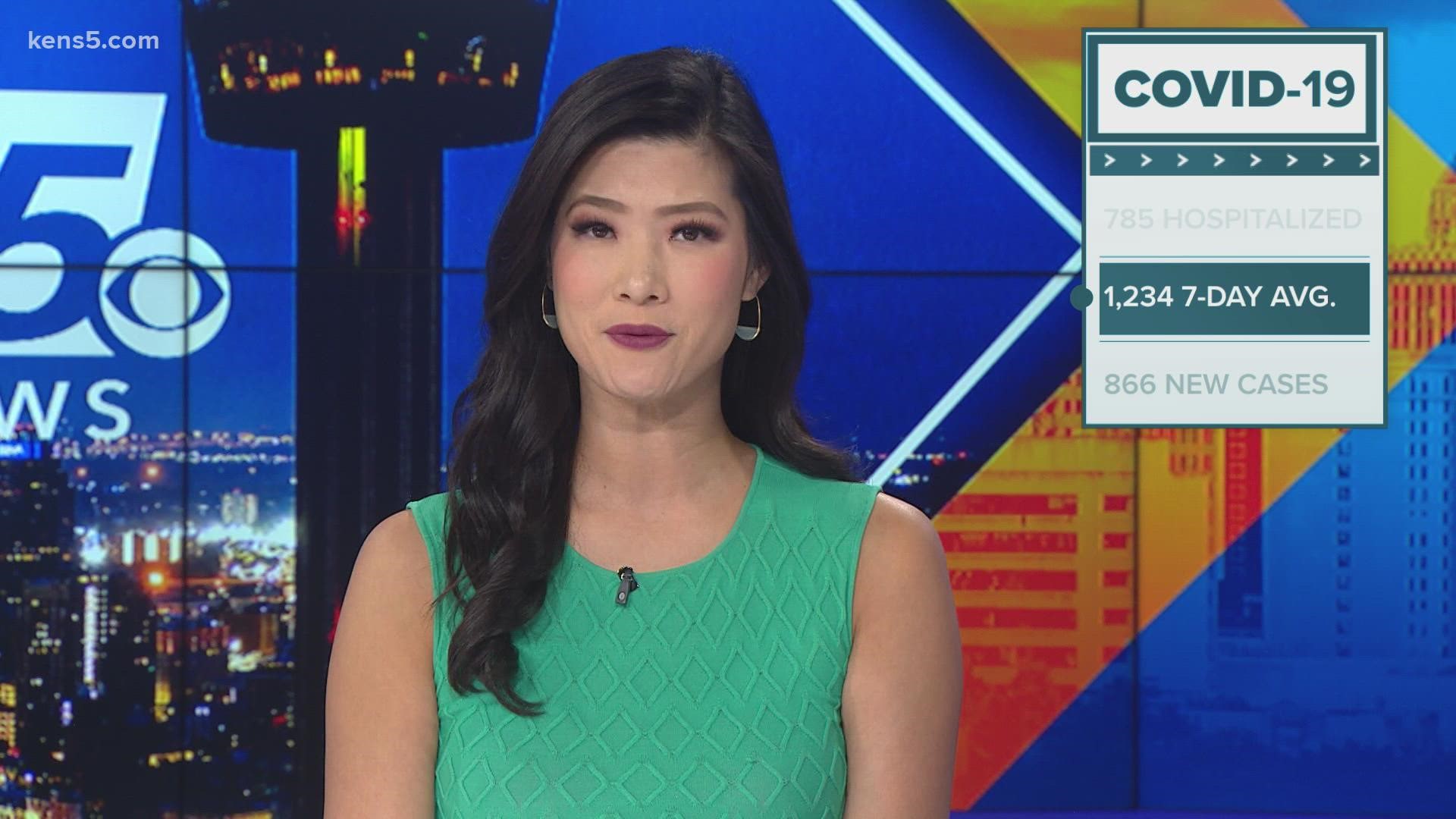SAN ANTONIO — Bexar County COVID-19 hospitalizations have dropped by 34% so far in February as the area continues to rebound from its worst surge of the pandemic, which resulted in as many as 1,308 patients receiving treatment in local facilities on Jan. 26.
That number fell Friday for a fourth straight day, to 785, one of the biggest indications that omicron may finally be starting to ease up on the San Antonio area after resulting in thousands of new diagnoses in January. Just 866 new cases were reported Friday by Metro Health, which is the second-smallest daily total for 2022 so far.
Fewer than 1,000 cases have been tallied by health authorities every day for the past four days, after no such days were recorded in 2022 before Tuesday. Consequently, the seven-day case average fell again to 1,234, the lowest the figure has been since Jan. 1.
However, eight more virus-related deaths were also reported Friday for the county, bringing this week's total to 51. In all, 5,186 San Antonio-area residents have died from coronavirus complications, while more than 512,000 have been infected.
Of the 785 hospitalizations on Friday, 211 patients were in intensive care and 112 were using ventilators to help them breathe.
How Bexar County is trending




Vaccine Progress in Bexar County
The following numbers are provided by San Antonio Metro Health. A full breakdown can be found here.
- 1.738 million eligible Bexar County residents have received at least one dose of the coronavirus vaccine as of Thursday, Feb. 10.
- 1.413 million eligible Bexar County residents are fully vaccinated as of Thursday, Feb. 10.
The CDC states that "when a high percentage of the community is immune to a disease (through vaccination and/or prior illness)," that community will have reached herd immunity, "making the spread of this disease from person to person unlikely."
The City of San Antonio breaks down the vaccination rates by zip code on Metro Health's Vaccination Statistics page.
Coronavirus in Texas
The total number of coronavirus cases in the state since the pandemic began grew by 13,254 on Friday, according to the Texas Department of State Health Services. That total includes 9,778 new confirmed cases and 3,476 new probable cases. More details can be found on this page.
Friday's figures bring the total number of Texans diagnosed with COVID-19 to more than 6.436 million.
An additional 256 Texans have died from virus complications, meanwhile, raising the statewide death toll to 80,566.
Coronavirus symptoms
The symptoms of coronavirus can be similar to the flu or a bad cold. Symptoms include fever or chills, cough, shortness of breath or difficulty breathing, fatigue, muscle or body aches, headache, new loss of taste or smell sore throat, congestion or runny nose, nausea or vomiting, and diarrhea, according to the Centers for Disease Control.
Most healthy people will have mild symptoms. A study of more than 72,000 patients by the Centers for Disease Control in China showed 80 percent of the cases there were mild.
But infections can cause pneumonia, severe acute respiratory syndrome, kidney failure, and even death, according to the World Health Organization. Older people with underlying health conditions are most at risk.
Experts determined there was consistent evidence these conditions increase a person's risk, regardless of age:
- Chronic kidney disease
- COPD (chronic obstructive pulmonary disease)
- Obesity (BMI of 30 or higher)
- Immunocompromised state (weakened immune system) from solid organ transplant
- Serious heart conditions, such as heart failure, coronary artery disease, or cardiomyopathies
- Sickle cell disease
- Type 2 diabetes
- The CDC believes symptoms may appear anywhere from two to 14 days after being exposed.
Human coronaviruses are usually spread...
- Between people who are in close contact with one another (within about 6 feet).
- Through respiratory droplets produced when an infected person coughs, sneezes or talks. These droplets can land in the mouths or noses of people who are nearby or possibly be inhaled into the lungs.
- Some recent studies have suggested that COVID-19 may be spread by people who are not showing symptoms.
Help stop the spread of coronavirus
- Stay home when you are sick.
- Eat and sleep separately from your family members
- Use different utensils and dishes
- Cover your cough or sneeze with your arm, not your hand.
- If you use a tissue, throw it in the trash.
Find a Testing Location
City officials recommend getting a COVID-19 test if you experience fever or chills, cough, shortness of breath or difficulty breathing, fatigue, muscle or body aches, headache, new loss of taste or smell, sore throat, congestion or runny nose, nausea or vomiting, or diarrhea.
Here's a Testing Sites Locator to help you find the testing location closest to you in San Antonio.
Latest Coronavirus Headlines
- No, the alpha and beta variants of the coronavirus aren’t circulating in the US
- Can you get omicron twice? Austin infectious disease doctor weighs in
- Texas students, frustrated by limited COVID-19 protocols, turn to petition drives and walkouts
- FDA delays meeting on COVID vaccines for kids under 5
- No, there’s no evidence that COVID-19 vaccines cause infertility in women or men
- NISD lifting temporary indoor mask mandate that took effect in January
- Haven't gotten your free COVID tests in the mail yet? Here's what you need to do

